ESP AUDI A3 CABRIOLET 2015 User Guide
[x] Cancel search | Manufacturer: AUDI, Model Year: 2015, Model line: A3 CABRIOLET, Model: AUDI A3 CABRIOLET 2015Pages: 302, PDF Size: 73.83 MB
Page 61 of 302
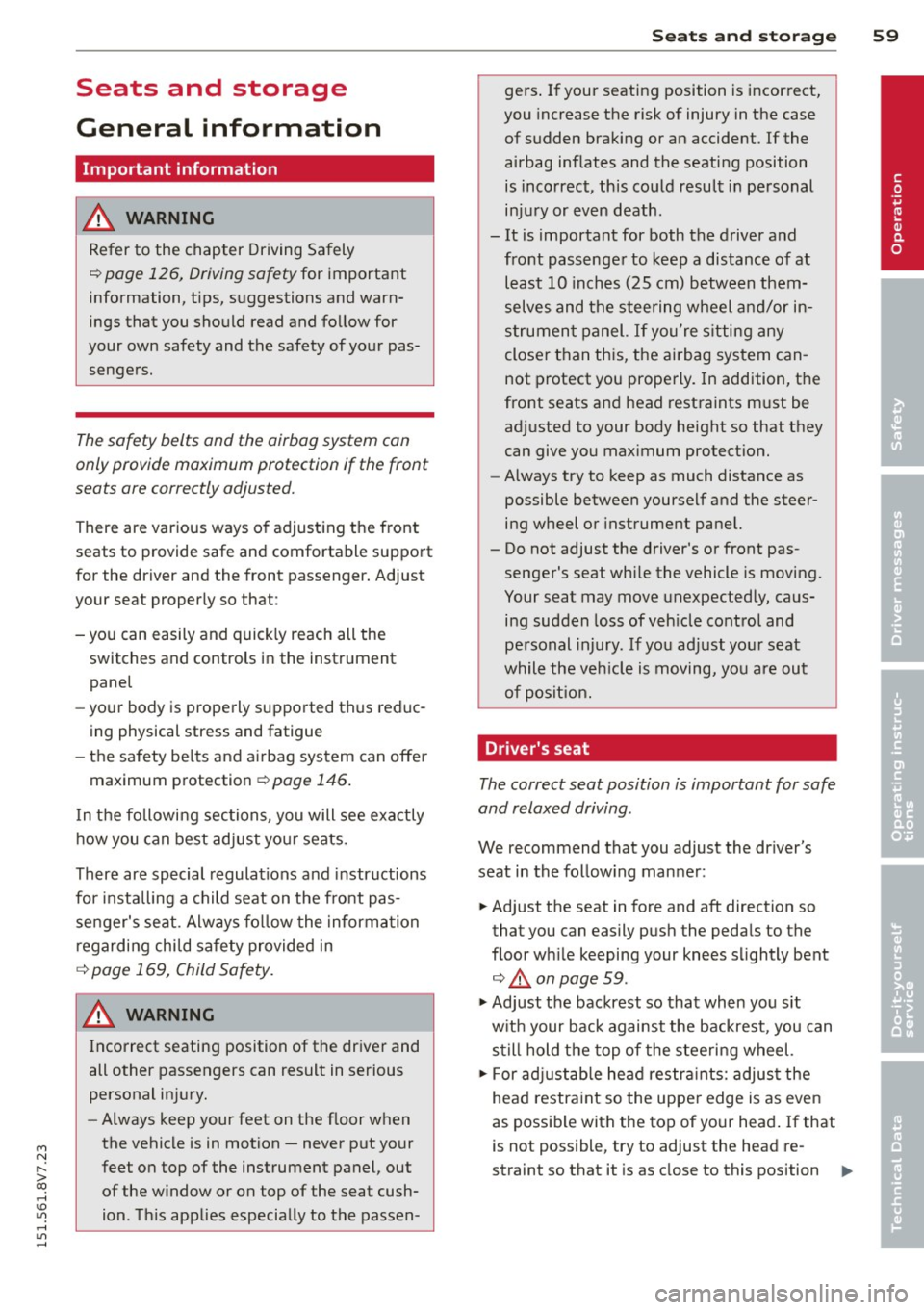
M N ,....
> co ,...., \!) ..,.,
,...., ..,., ,....,
Seats and storage
General information
Important information
A WARNING
Refer to the chapter Driving Safely
¢ page 126, Driving safety for important
information, tips, suggestions and warn
ings that you should read and follow for
your own safety and the safety of your pas sengers.
The safety belts and the airbag system con
only provide maximum protection if the front
seats ore correctly adjusted.
There are various ways of adjusting the front
seats to provide safe and comfortable support
for the driver and the front passenger. Adjust
your seat properly so that :
- you can easily and quick ly reach all the
switches and controls in the instrument
panel
- your body is properly supported thus reduc
ing physical stress and fatigue
- the safety be lts and airbag system can offer
maximum protection
¢ page 146.
In the following sections, you will see exactly
how you can best adjust your seats .
There are special regulations and instructions
for installing a child seat on the front pas
senger's seat. Always follow the information
regarding chi ld safety provided in
¢ page 169, Child Safety.
A WARNING
Incorrect seating position of the driver and
all other passengers can result in serious
personal injury.
- Always keep your feet on the floor when
the vehicle is in motion -never put your
feet on top of the instrument panel, out
of the window or on top of the seat cush ion. This applies especially to the passen-
Seats and storage 59
gers. If your seating position is incorrect,
you increase the risk of injury in the case
of sudden braking or an accident. If the
airbag inflates and the seating position is incorrect, this could result in pe rsonal
injury or even death.
- It is important for both the driver and
front passenger to keep a distance of at
least 10 inches (25 cm) between them
selves and the steering wheel and/or in
strument panel. If you're sitting any
closer than this, the airbag system can
not protect you properly. In addition, the
front seats and head restraints must be
adjusted to your body height so that they
can give you maximum protect ion.
- Always try to keep as much distance as
possible between yourself and the steer
ing wheel or instrument panel.
- Do not adjust the driver's or front pas
senger's seat whi le the vehicle is moving.
Your seat may move unexpectedly, caus
ing sudden loss of veh icle control and
personal injury. If you adjust your seat
while the veh icle is moving, you are out
of posit ion.
Driver's seat
The correct seat position is important for safe
and relaxed driving .
We recommend that you adjust the dr iver's
seat in the follow ing manner:
"" Adjust the seat in fore and aft direction so
that you can easily push the pedals to the
floor wh ile keeping your knees slightly bent
¢ &, on page 59.
"" Adjust the backrest so that when you sit
w ith your back against the backrest, you can
still hold the top of the steering wheel.
""For adjustab le head restra ints: adjust the
head restraint so the uppe r edge is as even
as possible with the top of your head. If that
is not possible , try to adjust the head re
straint so that it is as close to this position ..,_
•
Page 72 of 302

70 Warm and cold
Warm and cold Climate control system
Description
Different systems could be installed.
- manual climate control system* or
- automatic climate control system*
The
climate control system* cools and re
moves humidity from the air in the vehicle in
terior. It is the most effective when the win
dows and power top are closed. If there is a
build-up of heat inside the vehicle, ventila tion
can help to speed up the cooling process. Be
cause of this, the windows can be opened
from outside .
~ page 39, Convenience open
ing/closing
Pollutant filter
The pollutant filter removes pollutants such
as dust and pollen from the air .
Key recognition
You can store various settings for the manual
and automatic
climate control system* and
assign them to the key being used .
A WARNING
Poor visibility can lead to accidents.
- For safer driving, keep a ll windows free
of ice, snow and fog.
- Become familiar as quickly as possible
with the correct use and function of the
climate control system, especially with
the defrosting and defogging function .
- When the temperature is below freezing,
only use the windsh ield washer system
after the w indshield has been warmed by the cl
imate control system . The washer
fluid could freeze on the windshield and
impair visibility.
(D Note
- If you suspect that the climate control
system is damaged, switch the system
off to prevent further damage and have
it checked by an authorized Audi dealer
or authorized Audi Service Facility.
- Repairs to the Audi climate control sys
tem require special technical knowledge
and special tools. See an authorized Audi
dealer or authorized Audi Serv ice Facility .
® For the sake of the environment
Reducing the amount of fuel used also re
duces the amount of pollutants that enter
the air.
(D Tips
- To prevent interference with the heating
and cooling output and to prevent the
w indows from fogging over, the air in
take in front of the windshield must be
free of ice, snow or leaves.
- Condensation from the cooling system*
can drip and form a puddle of water un
der the vehicle. This is normal and does
not mean there is a leak.
- T he energy management system may
switch the seat heating* or rear window
defroster off temporari Ly. These systems
are available again as soon as the energy
balance has been restored.
- The flows through the vents under the
rear window. Make sure the openings are
not covered when placing clothing on the
luggage compartment cover.
Page 85 of 302
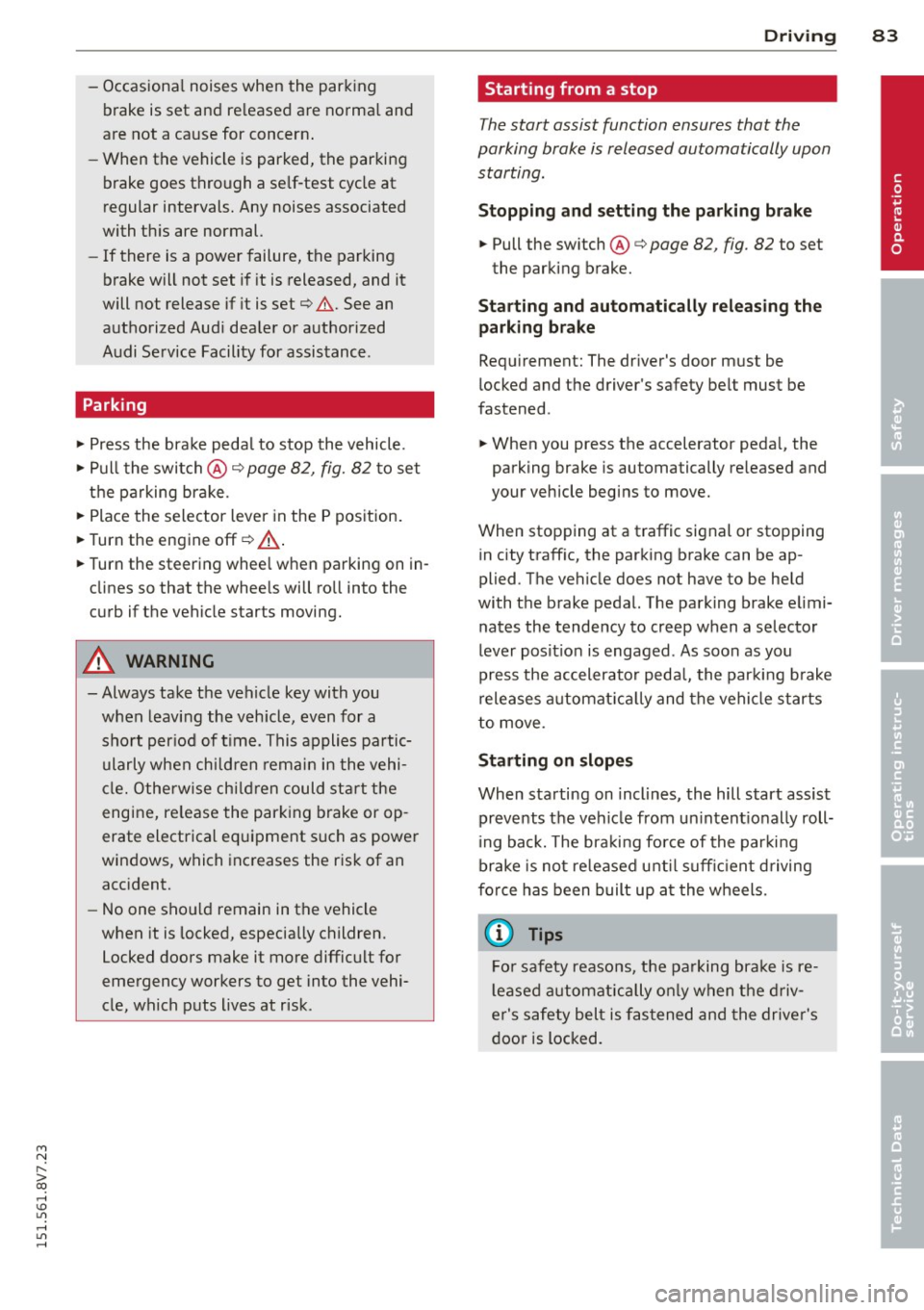
M N
" > co ,...., \!) ..,.,
,...., ..,., ,....,
-Occasiona l noises when the parking
brake is set and re leased are norma l and
are not a ca use for concern .
- When the vehicle is parked, the parking
brake goes through a se lf-test cycle at
regular intervals. Any noises associated
with th is are normal.
- If there is a power failure, the parking
brake will not set if it is released, and it
will not release if it is set c::>
,&. See an
authorized Audi dea ler or authorized
Audi Service Facility for assistance .
Parking
"'Press the bra ke peda l to stop the vehicle.
"' Pull the switch@c::>
page 82, fig. 82 to set
t h e parking bra ke.
"' Place the selector lever in the P position .
"'T urn the eng ine
off c::> _& .
"'Turn the steering whee l when parking on in
clines so that the whee ls will ro ll into the
curb if the vehicle starts moving.
A WARNING
-Always take the vehicle key with you when leaving the veh icle, even for a
short per iod of t ime. This applies partic
u larly when ch ild ren remain in the vehi
cl e. Otherwise chi ld ren could sta rt the
engine, re lease the par king brake or op
erate electrical eq uipment such as powe r
w indows, which increases the risk of an
acc ident.
- No one sho uld remain in the vehicle
when it is locked, especia lly children.
Locked doors make it more diffic ult for
emergency workers to get into the vehi
cle, which puts lives at risk.
Dri vin g 83
Starting from a stop
The start assist function ensures that the
parking brake is released automatically upon starting .
Stopping and setting the parking brake
"' Pull the sw itch @c::> page 82 , fig. 82 to set
the parking brake.
Sta rting and automatically rel easi ng the
parking brake
Req uirement: The dr iver's door must be
locked and the driver's safety belt must be
fastened.
"' When you press the accelerator peda l, the
parking brake is automatically re leased and
your vehicle begins to move.
When stopping at a traffic signal or stopping in city traff ic, the parking brake can be ap
plied . The vehicle does not have to be held
with the brake pedal. The parking brake elimi nates the tendency to creep when a selector
lever pos it io n is engaged. As soon as you
press the accelerato r peda l, the par king b rake
r eleases a utomat ica lly and the vehicle starts
to move.
Starting on slopes
When sta rting on incl ines, the hill start assist
prevents the vehicle from un intent ionally roll
i ng ba ck. The bra kin g fo rce of the par kin g
brake is not re leased unt il su ff ic ient d riving
f o rce has been built up a t the wheels.
(D Tips
Fo r safety reaso ns, t he pa rking bra ke is re
l eased automatic ally o nly when the d riv
er's safety bel t is fa stened an d the driver's
d oor is locked.
•
Page 87 of 302
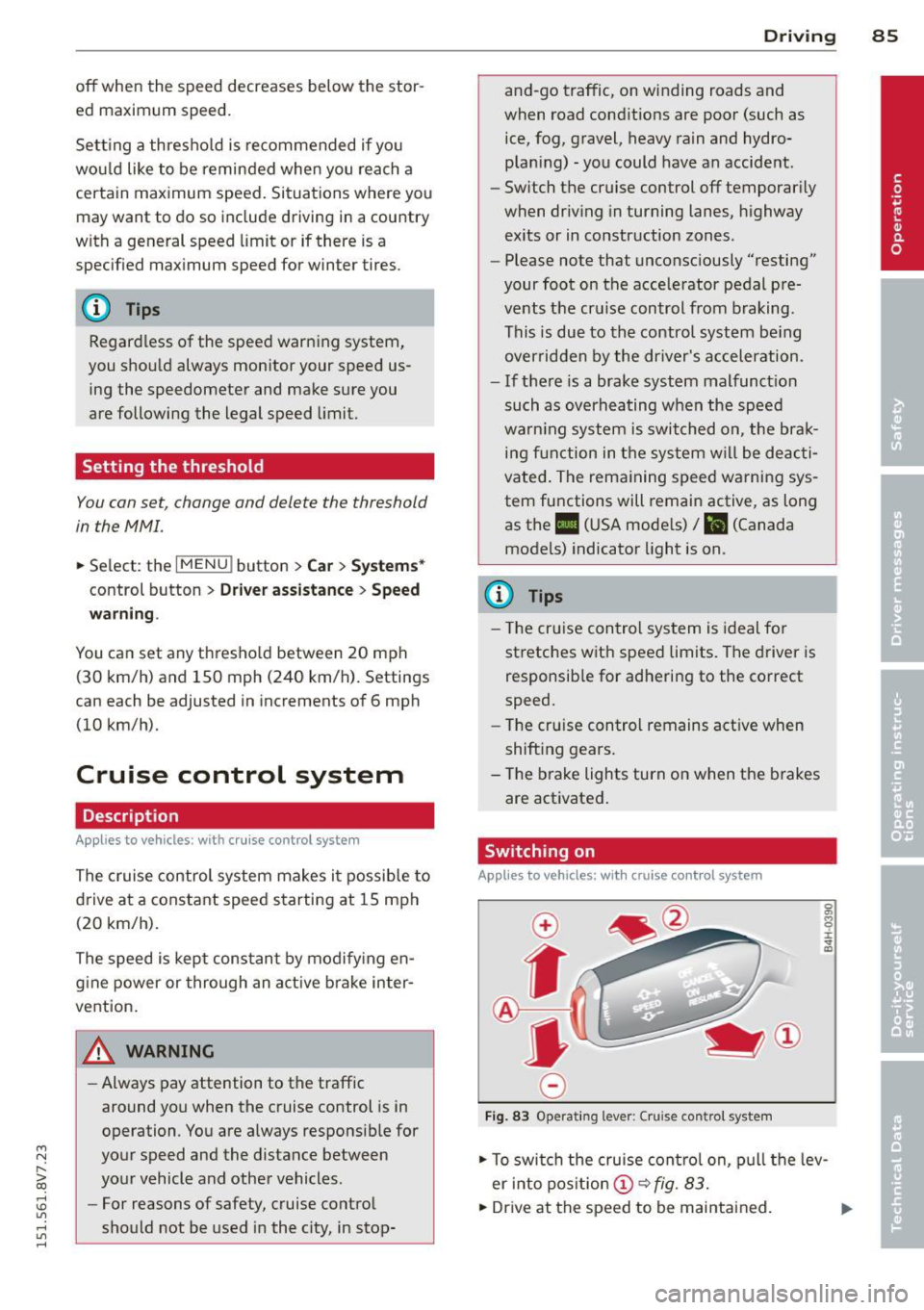
....,
N
r--. > co
rl I.O
"' rl
"' rl
off when the speed decreases below the stor
ed maximum speed.
Setting a thresho ld is recommended if yo u
wo uld like to be reminded when you reach a
certain maximum speed . Situations where you
may want to do so include d riving in a country
with a general speed limit or if there is a
specified max imum speed for winter tires.
@ Tips
Regard less of the speed warning system,
you shou ld always mon itor your speed us
ing the speedometer and make sure you
are following the legal speed limit.
Setting the threshold
You con set, change and delete the threshold
in the MMI.
• Se lect : the
IMENU ! button> Car> System s*
control button > Driv er assist an ce > Speed
w arning .
You can set any thresho ld between 20 mph
(30 km/h) and 150 mph (240 km/h). Settings
can each be adjusted in increments of 6 mph
(10 km/h).
Cruise control system
Description
Appl ies to vehicles : with cruise con trol system
The c ruise control system makes i t possible to
d rive at a constant speed starting at lS mph
(20 km/h).
The speed is kept constant by modify ing en
g ine power or through an a ct ive brake in ter
vention.
A WARNING
- Always pay attention to the traffic
around you when the cruise control is in
operation. You are always responsible for
your speed and the distance between
your vehicle and other vehicles.
- For reasons of safety, cruise contro l
should not be used in the c ity, in stop-
Dri vin g 85
and-go traffic, on winding roads and
when road cond itions are poor (such as
ice, fog, gravel, heavy rain and hydro
plan ing) -you could have an accident.
- Switch the cruise control off temporarily
when dr iv ing in turning lanes, h ighway
e xits or in construction zones.
- Please note that unconsc iously "resting"
your foot on the accelerator pedal p re
vents t he cr uise control from b raking.
This is due to the control system be ing
over ridden by the dr iver's acceleration .
- If the re is a brake system malfunct ion
such as overheating when the spee d
warn ing system is switched on, the bra k
ing f unction in the system w il l be deac ti
vated . The remaining speed warning sys
tem fu nctions will remain active, as long
as the
Ill ( U SA mode ls) I l'I (Canada
models) indicator light is on.
(D Tips
- T he cr uise control system is ideal fo r
st retches wit h speed limits. The driver is
responsib le for adhering to the correct
speed.
- The cr uise control remains act ive when
shift ing gears.
- The b ra ke lights turn on when the b rakes
are act ivated.
Switching on
Applies to vehicles: with cruise control system
Fi g. 83 Operat ing lever: Cruise control system
• To swi tch the cruise cont ro l on, p ull the lev
er into pos it ion @
~fig. 83.
• Dr ive at the speed to be maintained.
Page 89 of 302
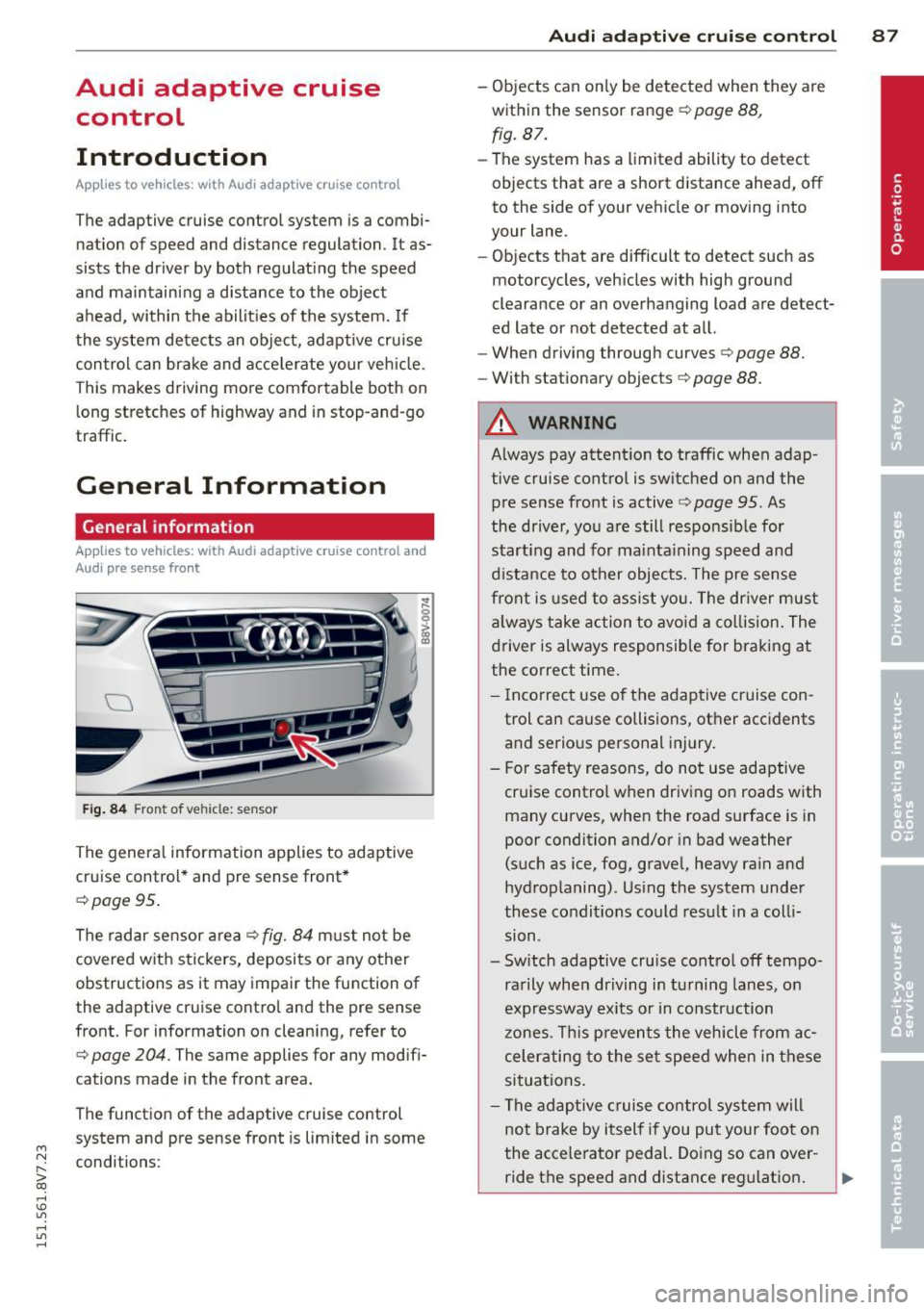
....,
N
" > co
rl I.O
"' rl
"' rl
Audi adaptive cruise control
Introduction
App lies to vehicles: with Audi adaptive cruise control
The adaptive cruise control system is a com bi·
nation of speed and distance regulation. It as
sists the dr iver by both regulat ing the speed
and maintain ing a distance to the object
ahead, within the abilities of the system. If
the system detects an object, adaptive cru ise
control can brake and acce le rate your ve hicle.
This makes driving more comfortable both on l ong stretches of highway and in stop-and -go
traffic.
General Information
General information
Applies to vehicles: with Audi adaptive cruise co ntrol a nd
Audi pre sense fro nt
Fi g. 84 Front of vehicle: sensor
The genera l information applies to adaptive
cr uise control* and pre sense front *
c::>page95.
The radar se nsor a rea c::>fig. 84 must not be
covered w it h stickers, deposits or any other
obstructions as it may impair the function of
the adaptive cruise contro l and the pre sense
front. For information on cleaning, refer to
,:t 0 0 > l8
c::> page 204. The same applies for any modifi
cations made in the front area.
The function of the adaptive c ruise control
system and pre sense front is lim ited in some
conditions :
Audi ad apti ve crui se control 8 7
- Objects can only be detected when they are
within the sensor range
c::> page 88,
fig. 87 .
-The system has a limited ability to detect
objects that are a short d istance ahead, off
to the side of your vehicle or moving into
your lane.
- Objects that are difficult to detect such as
motorcycles, veh icles with high ground
clearance or an overhanging load are detect
ed late or not detected at all.
- When driving through curves
c::>page 88.
-With stationary objects c::> page 88 .
A WARNING
Always pay attent ion to traffic when adap
tive cruise control is switched on and the
pre sense front is active
c::> page 95. As
the driver, you are s till respons ib le for
start ing and fo r ma inta in ing speed and
d is ta nce to o ther objec ts. The pre sense
front i s used to ass ist yo u. The dr iver must
al ways take ac tion to avo id a col lision . The
driver is always responsible for braking at
the correct time .
- I ncorrect use of the a daptive cr uise con
trol can cause collisions, ot her accidents
an d serio us pe rsonal inj ury .
- For safety reasons, do not use adaptive
cru ise contro l when driv ing o n roads with
many curves, when the road s urface is in
poor condition and/or in bad weather
(such as ice, fog, grave l, heavy ra in and
hydroplaning). Using the system unde r
these co ndit ions co uld res ult in a coll i
sion.
- Sw itch adaptive cru ise cont ro l off tempo·
ra rily whe n driving in tu rni ng lanes, o n
expressway ex its or in construction
zones. T his preven ts the vehicle from ac
celerating to the se t speed when in t hese
situations .
- Th e adap tive cruise control system
will
not brake by i tsel f if you pu t your foo t on
the accelera to r pedal. Do ing so can ove r-
ride t he speed and distance reg ulat io n.
~
Page 90 of 302

88 Audi adaptive cruise control
- When approaching stationary objects
such as stopped traff ic, adaptive cruise
control will not respond and pre sense
front will have limited function.
- The adaptive cruise control system and
pre sense front do not react to people,
animals, objects cross ing the road or on
coming objects.
- The function of the radar sensors can be
affected by reflective objects such as
guard rai ls, the entrance to a tunnel,
heavy rain or ice.
- Never follow a veh icle so closely that you
cannot stop your vehicle safe ly. The
adaptive cruise control cannot slow or
brake the vehicle safely when you follow
another vehicle too closely. Always re
member that the automatic braking
function ca nnot bring the veh icle to a
sudden or emergency stop under these
condit ions.
- To prevent unintended operation, always
switch ACC off when it is not be ing used.
(D Note
The sensor can be disp laced by impacts o r
damage to the bumper, whee l housing and
underbody . The adaptive cruise contro l
and pre sense front may become impaired
as a result . Have an authorized Audi dealer
or author ized Audi Service Facility check
their function.
In curves
Applies to vehicles: with Audi adaptive cruise control and
Audi pre sense fro nt
Fig. 85 Examp le: driv ing into a curve
When driving into a curve c::> fig. 85 and out of
a curve, the adaptive cruise control may react
to an object in the neighboring lane and apply
the brakes. You can prevent that by pressing
the accelerator pedal briefly .
Stationary objects
Applies to vehicles: with Audi adaptive cruise contro l and
Audi pre sense front
Fig. 86 Example: object chang ing lanes a nd stationary
object
Adaptive crui se control
The adaptive cruis e control system only reacts
to objects that are moving or that the system has a lready detected as moving. For examp le,
if a detected vehicle @tur ns or changes
lanes, the adaptive cruise control will not re
act to a stopped vehicle @. Press the brake
pedal to slow your vehicle down .
Pre sense front
Pre sense front only reacts to stationary ob
jects at low speeds.
Adaptive cruise control
Description
Applies to vehicles: with Audi adaptive cruise control
--~.....,
~~ 'l! !/.~~!!iii
Fig. 87 Detectio n ran ge
Page 98 of 302

96 Audi pre sense
Warnings
App lies to vehicles: with Audi pre sense front or Audi
adaptive cruise control
Fig. 94 Instrument cluster: approac h warning
The system recognizes various dangerous sit
uations:
- Vehicles with adaptive cruise control : The
distance warning occurs if you drive too
closely to the object ahead for a long period
of t ime. If the object ahead brakes strongly,
you would not be able to avoid a coll ision.
The indicator light . indicates this.
- The
approach warning occurs when an ob
ject ahead is traveling mo re slowly or brakes
strongly. When this warning occurs, it may only be possible to avoid a collision by
swerving or braking strongly. The message
Audi pre sense. Distance ¢ fig . 94 and a
warning tone will warn you about the dan ger. For vehicles with adaptive cruise con
trol, the. indicator light also turns on.
If you do not react enough or not at all to a
dangerous situation that was detected by the
system, pre sense front provides ass istance by
applying the brakes.
- If a collision is imminent, the system will
first provide an
acute warning by braking
sharply. You will also be made aware of the
danger by the instrument cluster display
¢
fig. 94. F or vehicles with adaptive cruise
control, the. indicator light also turns on.
- If you do not react to the acute warning, pre
sense front can brake with increasing force
within the limits of the system
ll. This re
duc es the vehicle speed in the event of a col-
l l Thi s is not available in som e coun tries .
lision. The message Audi pre sense -Input
also appears.
- At low driving speeds , pre sense front can
begin complete deceleration shortly before
a collision
ll .
- If pre sense front determines that you are
not braking strongly enough when a colli
sion is immin ent, it can increas e the braking
force.
A WARNING
- Pre sense front cannot overcome natural
physical laws. It is a system designed to
assist and it cannot prevent a collision .
The driver must always intervene. The
driver is always responsible for braking
at the correct time. Do not let the in
creased safety provided tempt you into
taking risks. This could increase your risk
of a collision.
- The system can deploy incorrectly due to
system-specific limits .
- Please note that the sensor does not al
ways detect all objects . This increases
the risk of a collision.
- Pre sense front does not react to people
or animals or objects that are crossing
the vehicle's path or are difficult to de
tect ¢
page 87, General Information.
-Reflective objects such as guard rails or
the entrance to a tunnel, heavy rain and
ice can affect the function of the radar
sensor and the system 's ability to detect
a collision risk .
- Lack of attention can lead to collisions,
other accidents and serious injuries. pre
sense front is an assistance system and
cannot prevent a collision by itself . The
driver must always intervene. The driver
is always responsible for braking at the
right time.
- Always pay attention to traffic, even
when pre sense front is switched on. Al-
ways be ready to intervene and take over
complete control of the vehicle whenever
~
Page 101 of 302
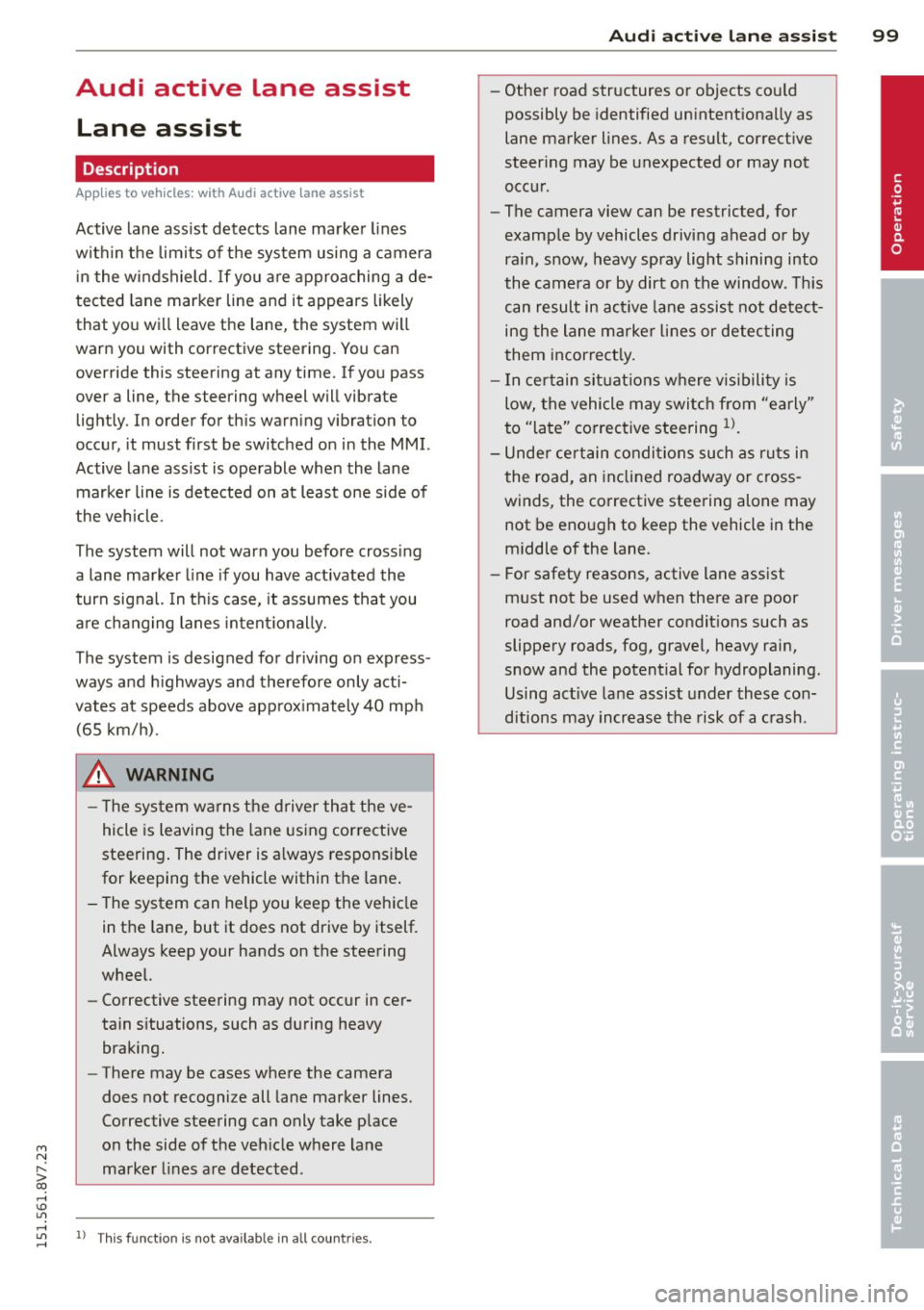
M N
" > co ,...., \!) ..,.,
Audi active Lane assist Lane assist
Description
Applies to vehicles: with Audi active lane assist
Active lane assist detects lane marker lines
within the limits of the system using a camera
in the windshield.
If you are approaching a de
tected lane marker line and it appears likely
that you will leave the lane, the system will
warn you with corrective steering. You can
override this steering at any time. If you pass
over a line, the steering wheel will vibrate
lightly. In order for this warning vibration to
occur, it must first be switched on in the
MMI.
Active lane assist is operable when the lane
marker line is detected on at least one side of
the vehicle.
The system will not warn you before crossing
a lane marker line if you have activated the
turn signal. In this case, it assumes that you
are changing lanes intent ionally.
The system is designed for driving on express
ways and highways and therefore only acti
vates at speeds above approximately 40 mph (65 km/h).
_& WARNING
- The system warns the driver that the ve
hicle is leaving the lane using corrective
steering. The driver is always responsible
for keeping the vehicle within the lane.
- The system can help you keep the vehicle
in the lane, but it does not drive by itself.
Always keep your hands on the steering
wheel.
- Corrective steering may not occur in cer
tain situations, such as during heavy
braking.
- There may be cases where the camera
does not recognize all lane marker lines.
Corrective steering can only take place
on the side of the vehicle where lane
marker lines are detected.
,....,
..,., 1) This function is not available in all countries. ,....,
Audi active lane assist 99
-Other road structures or objects could
possibly be identified unintentionally as
lane marker lines. As a result, corrective
steering may be unexpected or may not
occur.
- The camera view can be restricted, for
example by vehicles driving ahead or by
rain, snow, heavy spray light shining into
the camera or by dirt on the window. This
can result in active lane assist not detect
ing the lane marker lines or detecting
them incorrectly.
- In certain situations where visibility is
low, the vehicle may switch from "early"
to "late" corrective steering
l).
-Under certain conditions such as ruts in
the road, an inclined roadway or cross
winds, the corrective steering alone may
not be enough to keep the vehicle in the
middle of the lane.
- For safety reasons, active lane assist
must not be used when there are poor
road and/or weather conditions such as
slippery roads, fog, gravel, heavy rain,
snow and the potential for hydroplaning. Using active lane assist under these con
ditions may increase the risk of a crash.
Page 103 of 302
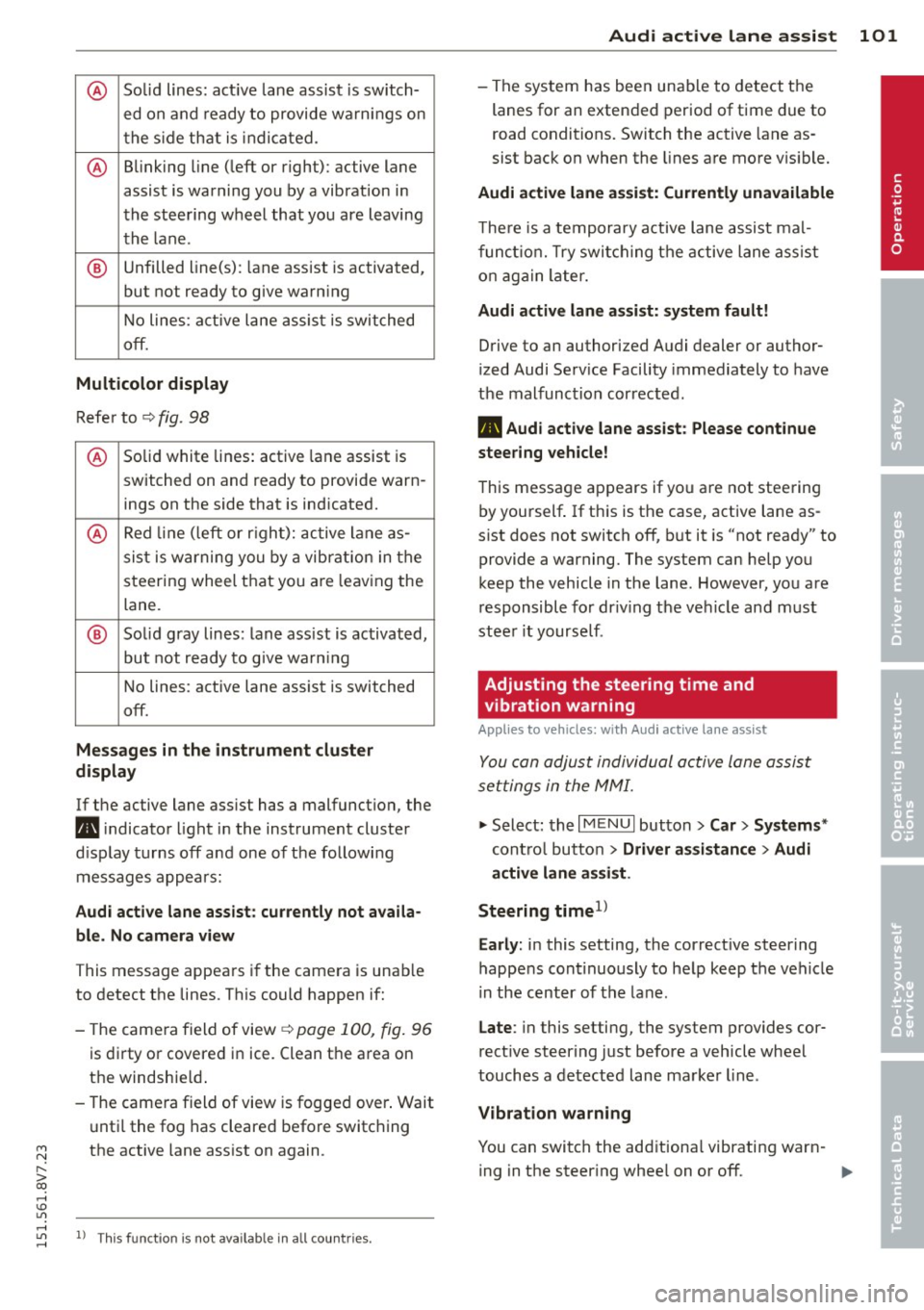
M N
" > co ,...., \!) 1.1"1
@ Solid lines: active lane assist is switch-
ed on and ready to provide warnings on
the side that is indicated.
@ Blinking line (left or right): active lane
assist is warning you by a vibration in
the steering wheel that you are leaving
the lane .
® Unfilled line(s): lane assist is activated,
but not ready to give warn ing
No lines: a ctive lane assist is switched
off.
Multicolor display
Refer to ¢ fig. 98
@ Solid white lines: active lane assist is
switched on and ready to provide warn-
ings on the side that is ind icated.
@ Red line (left or rig ht): active lane as-
sist is wa rning you by a vibrat ion in the
steering wheel that you a re leav ing the
lane.
® Solid gray lines: lane ass ist is activated,
but not ready to give warn ing
No lines: active lane assist is switched
off.
Messages in the instrument cluster
display
If the active lane ass ist has a malfunction, the
m, i ndicato r light in the instrument cluster
d isplay turns off and one of the following
messages appears:
Audi active lane assist: currently not availa
ble. No camera view
This message appears if the camera is unab le
to detect the lines . This could happen if:
- The camera field of view
¢ page 100, fig. 96
is dirty or covered in ice. Clean the area on
the windshie ld.
- The camera field of view is fogged over. Wait
until the fog has cleared before switching
the active lane assist on again.
,....,
1.1"1 l) This funct ion is not availab le in all coun tries. ,....,
Audi active lane assist 101
- The system has been unable to detect the
lanes for an extended period of time due to
road conditions. Switch the active lane as
sist back on when the lines are more v is ibl e.
Audi active lane assist: Currently unavailable
The re is a temporary active lane assist mal
function. Try switching the active lane assist
on again later.
Audi active lane assist: system fault!
Drive to an authorized Audi dealer or author
ized Audi Serv ice Facility immediately to have
the malfunction corrected.
m, Audi active lane assist: Please continue
steering vehicle!
This message appears if you are not steering
by yourself . If th is is the case, active lane as
s ist does not switch off, but it is "not ready" to
provide a warning. The system can help you
keep the vehicle in the lane . However, you are
responsible for driv ing the vehicle and must
steer it yourself .
Adjusting the steering time and
vibration warning
App lies to veh icles : w ith Audi ac tive la ne ass ist
You con adjust individual active lone assist
settings in the MMI.
""Select: the I MENU I button >Car > Systems *
control button > Driver assistance > Audi
active lane assist .
Steering time
1>
Early: in this setting, the correct ive steering
happens cont inuously to help keep the veh icle
i n the center of the lane.
Late : in this setting, the system provides cor
rect ive steer ing just before a vehicle wheel
touches a detected lane marker line .
Vibration warning
You can switch the additiona l vibrating warn-
ing in the steer ing whee l on or off. ..,_ •
Page 109 of 302

M N
" > co ,...., \!) 1.1"1 ,...., 1.1"1 ,....,
Audi drive select Driving settings
Introduction
Applies to vehicles: with Audi drive select
Audi drive select makes it possible to experi
ence diffe rent types of vehicle settings in one
vehicle. The driver can select from three
com
fort , auto
and dynamic modes using the 1:1:.~
button in the center conso le or the MM I to
switch between a sporty and a comfortable
driving mode, for examp le. In the
individual *
mode, the settings can be adjusted to your
personal preferences. This makes it poss ible
to combine settings such as a sporty eng ine
tuning with light steering.
A WARNING
Using Audi drive select incorrectly can lead
to collisions, other accidents and serious injuries.
Description
Applies to vehicles: with Audi drive select
The vehicle setup in each mode depends on
the vehicle's features. However, the engine
and steering are always affected .
Engine and automatic transmission
Depending on the mode, the engine and auto
mat ic transmission* respond more quickly or
in a more balanced manner to acce lerator
pedal movements.
Adaptive dampers (Audi magnetic ride)*
The adaptive dampers use senso rs to record
information regarding steering movements,
brak ing and acce lerat ion operat ions by the
driver, road surface, driving speed, and load.
With Audi drive se lect you can adjust the
adaptive dampers sporty (dynamic), comfort
ab le (comfort) or balanced (auto).
Steering
The stee ring adapts in terms of stee ring assis
tance. There are different modes
¢page 108.
Indirect steering that moves easi ly as in com -
Audi drive select 107
fort mode is especially suited to long drives
on a highway. The dynamic mode provides
sporty, direct steer ing.
For vehicles wi th progressive steering* the
steering performance is mo re agile.
Cornering light*
The cornering light adjusts when driv ing on
curves at speeds between 6 mph (10 km/h)
and 68 mph (110 km/h). The pivoting action
and the lighting are also adapted to the
mode.
Adaptive cruise control*
T he behav ior when accelerating can be adjust
ed from comfortable to sporty, depending on
the Aud i drive select mode. Adapt ive cru ise
control also responds to the driving behavior
of the vehicle ahead in a more conservative or
sporty manner.
(D Tips
In some mode ls, the maximum vehicle
speed can only be reached in the auto and
dynamic modes.
•